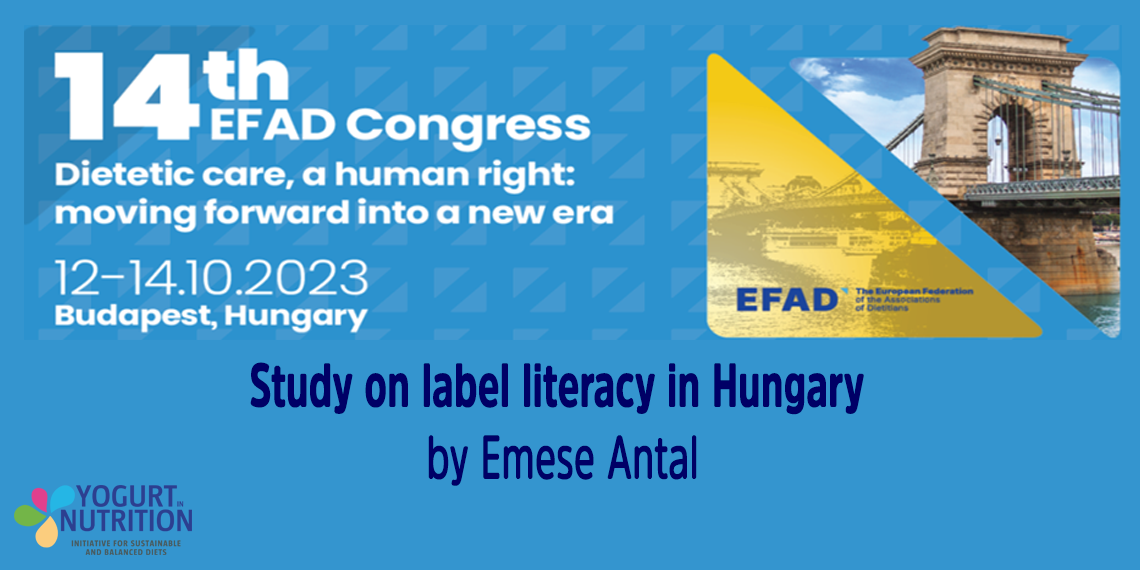In October 2023, the 14th EFAD (European Federation of Association of Dieteticians) Congress was the occasion of exchange and networking around nutrition. We were there to share with you some topics.
Study on label literacy in Hungary
Consumers are paying more and more attention to choose foods they think are healthy. Most of the help they need is on the product packaging. A previous research has shown that although consumers may pay attention, they often do not fully understand the information on foods, making it difficult for them to make a truly informed choice when shopping.
We conducted a survey in Summer 2022 to gain a deeper understanding on how nutrition labels are used and what consumers know. The survey was based on a representative sample of 3 288 people by household size, size of municipality, region and gender, age and education of the head of household.
57% read the food label, mainly when buying a product for the first time or when the packaging changes. When asked about their satisfaction with the information on the labels, 44% said they were satisfied. On average, shoppers look at 9 items on a product. 51% do not know what ingredients are in the product. 40% of the shoppers want more information and would find it useful to have a QR code to get more information.
The ideal label is simple, easy to read according to 88% and easy to understand due to its large font size (71%). However, the majority of households are not in favor of oversimplification: more than six-tenths of the households are expecting full, accurate and detailed information, and not only the data to be provided, but also to be interpreted and comparable (63%).
Dietitians have a key role to play in education, including teaching people how to interpret food labels.
Key messages:
- Consumers’ knowledge of health and interpretation of food labels is poor and below the required level.
- Consumers can be educated, welcome useful, credible health information and incorporate it into their daily lives.
- Health awareness is on the rise, which is also reflected in food choices. At the same time, however, there is also a significant spread of misconceptions
Learn more with Emese Antal
Can you start by introducing yourself?
I am Emese Antal and I am a dietician and sociologist. I am working as a scientific director of a Hungarian Platform Diet, Health and Physical Activity.
During your talk, you present a study. Can you tell us more about it ?
We carried out representative study on the nutrition labelling and not only on the front-of-pack nutrition labelling, but the general nutrition labelling, because we wanted to evaluate the knowledge and attitudes of the population in Hungary.
Our aim was that to obtain basic data to help us to building communication and educational strategy, in order to teach the population about healthy nutrition and how to read the labels.
The consumers are price sensitive, looking for fresh and tasty food, concerned about quality and nutritional characteristics. It’s very important to provide as much information on food as possible and to be transparent. A further challenge for public authorities and professionals as dietitians is to provide as much help as possible, to help understanding the information on packaging.
One of the major concerns is about carbohydrate and sugar content of foods. And it’s important from a public health perspective, as overweight and obesity are a major concern. There is a need for accurate information on the nutritional content of foods and for responsible behavior by our manufacturers. And our conclusion is that food innovations can help to promote healthier behavior. But of course, education is always needed.
Do you know tools or ways to educate the consumer?
We compared three front-of-pack labels and it came out that “Nutriscore” primarily appears to its supporters. It is easy to understand and attention grabbing. We check the GDA as well. It is perceived as detailed, accurate, complete, and encourages people to seek further information.
And what would be the ideal front-of-pack label if it exists ?
The nutrition labelling cannot be effective if there is no possibility of comparison. For now, there is a trend toward a simplification and the application of only one label in all Europe (at least). This is good that it is widely used, both on products and in food chains and catering. However, it should be accompanied by an appropriate consumer education.



